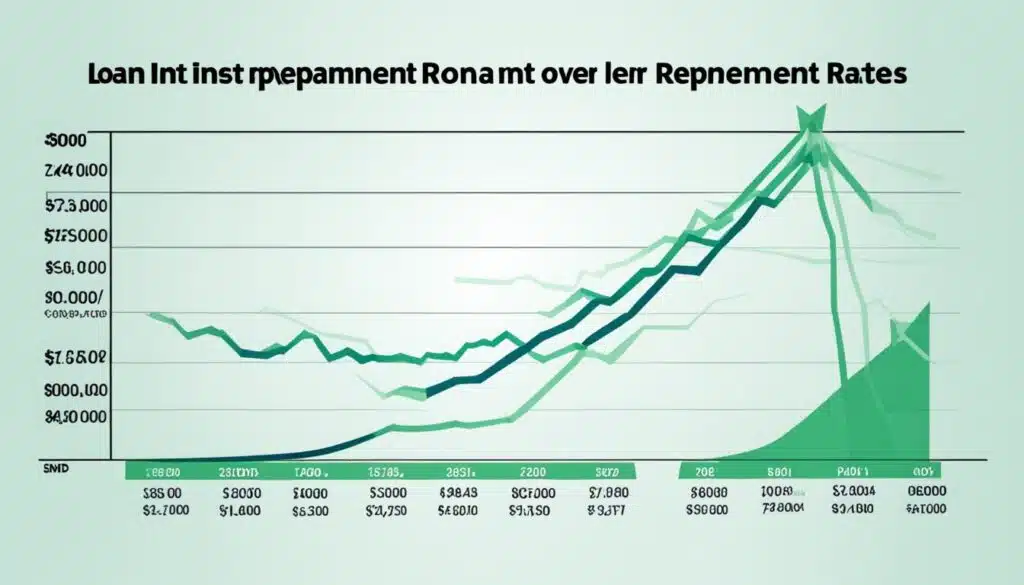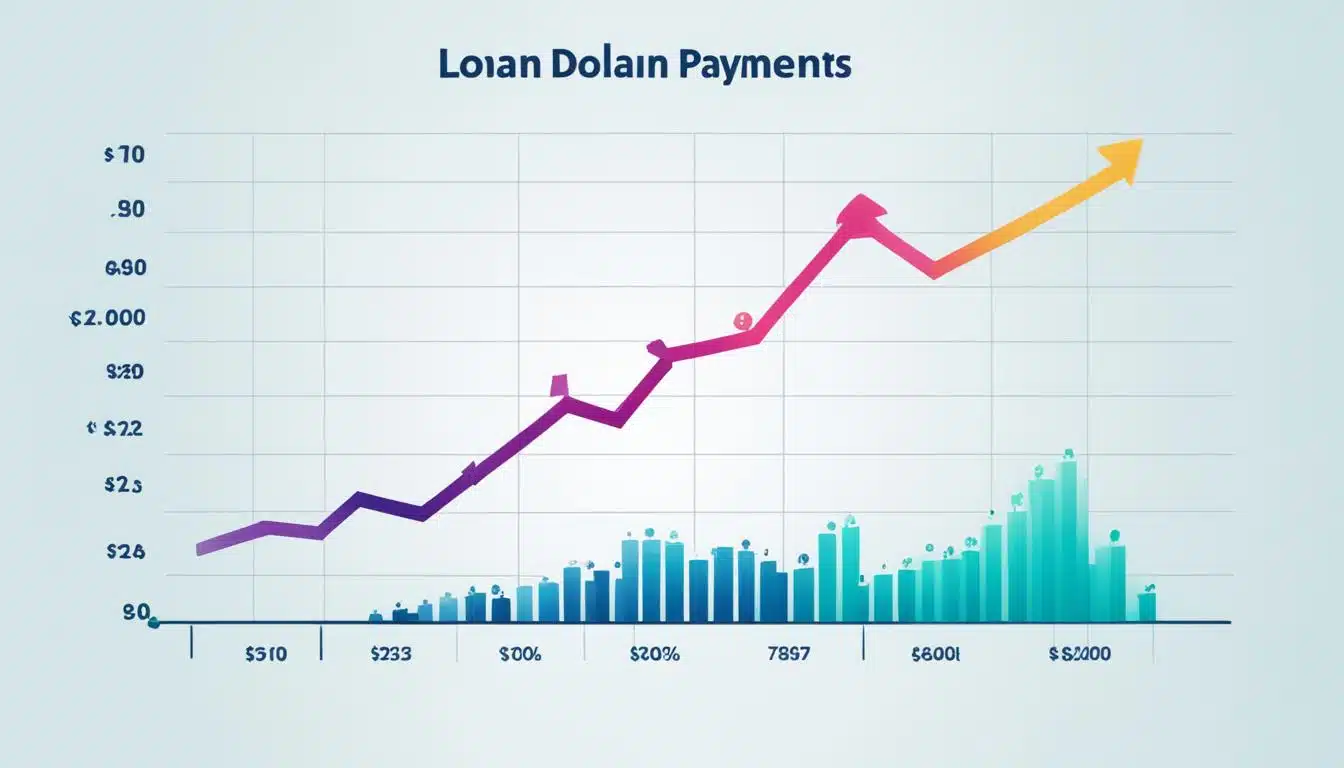It’s key to understand loan constant and amortization when dealing with debt. Loan constant shows the yearly debt service against the initial loan amount. Amoartization is about gradually paying off a loan with consistent payments toward both principal and interest. Calculating loan constant is done by taking the annual debt service and dividing it by the loan amount. Mastering these ideas helps people borrow wisely and manage money well. Lenders, too, use loan constant for checking a loan’s risk and profit.
Key Takeaways
- Loan constant is the ratio of annual debt service to the total loan amount.
- Amortization is the process of gradually paying off a loan through regular payments that include both principal and interest.
- Understanding loan constant and amortization can help borrowers make informed decisions and plan their finances effectively.
- Lenders can use loan constant to assess the profitability and risk associated with a loan.
- Careful review of loan terms and conditions is crucial to avoid unexpected fees or changes in interest rates.
Understanding Loan Constant and Amortization
Loan constant, or the mortgage constant, is key in seeing how much of the loan goes to yearly debt service. It’s good for both those borrowing and those lending. It shows if a loan is doable and profitable. What’s cool is that this number stays the same over time, making it easy to compare loans.
Defining Loan Constant
Loan constant shows the yearly debt service as a part of the loan amount. It’s the part of the loan, both principal and interest, that you pay each year.
Defining Amortization
Amortization means paying off a loan over time with set payments. These include both the principal and interest. As you pay, the amount for interest goes down and principal goes up.
Calculating Loan Constant
To find the loan constant, divide the yearly debt service by the total loan amount. This shows how much needs to be paid each year.
Impact on Borrowers
Understanding loan constant helps borrowers see if they can afford their loans. A lower constant means better loan service ratio. This gives borrowers more financial flexibility and less stress.
Impact on Lenders
Lenders use loan constant to check if a loan is profitable and risky. A high loan constant suggests more risk. This is because more of the loan is for yearly debt service.
What is Loan Constant and How Does it Work?
Loan constant is the ratio of yearly debt service to the total loan. It shows the percent of the loan paid each year for interest and principal. You find the loan constant by dividing yearly debt service by the total loan.
Definition and Calculation
Loan constant is a key figure for both borrowers and lenders. It’s found by dividing the annual debt service by the total loan. This lets you see the yearly financial burden of the loan, helping to compare different loans.
Significance of Loan Constant
Understanding loan constant is crucial for evaluating the long-term cost of a loan. It helps borrowers see if they can manage the loan over time. Lenders use this to judge if the loan is profitable and the level of risk.
Impact on Cash Flow
Loan constant affects how much money from a borrower’s income goes to the loan each year. A higher loan constant takes more from the borrower’s income. This could limit their spending on other needs. A lower loan constant gives more spending flexibility.
Relationship with Interest Rates
Loan constant changes with interest rates. If rates go up, more of the payment goes to interest. When rates fall, more can go to the loan’s principal.
Example
Consider a loan of $500,000 with $35,000 yearly debt service. Dividing these gives a loan constant of 0.07, or 7%. This 7% shows what part of the loan is paid each year.
The Importance of Loan Constant in Debt Repayment

Loan constant is crucial for checking how steady debt payments are. It compares yearly debt service with the total loan balance. A small ratio here means payments are stable over time. This comforts both borrowers and lenders.
Predictability of Cash Flow
Loan constant is key for foreseeing cash flow’s steady flow for borrowers and lenders. It offers a clear picture of what payments are every year. This helps borrowers manage their budgets wisely. And for lenders, it shows how secure their investment is, improving their choice of loans.
Comparing Different Financing Options
For weighing financing choices, loan constant is a must. By looking at loan constants of various loans, borrowers can see the best option. It helps them understand the loan’s costs and future benefits. In the end, it guides borrowers to pick the right loan for their financial situation.
Amortization: Understanding Mortgage Repayment

Amortization means paying off a mortgage slowly over time. You make regular payments that include principal and interest. The principal is the loan amount, and the interest is the extra charge by the lender.
Over time, as you pay off the principal, less money goes to interest. Meanwhile, more cash starts going to pay down the principal.
What is Mortgage Amortization?
Mortgage amortization is how you steadily lower the loan amount. You do this with regular, scheduled payments during the loan’s life. Each payment includes some of the principal and some interest. But the part going to the principal slowly increases as the loan gets older.
How Does Mortgage Amortization Work?
Here’s how it goes: your total loan is divided into equal monthly payments. These include both principal and interest costs. At first, a big part of each payment covers the interest, and less is used for the principal.
Gradually, the interest bit gets smaller. More of your money then directly reduces what you owe.
Calculating Amortization: The Formula Unraveled

Understanding mortgage amortization is important. It shows where your monthly money goes. It also explains how each month’s payment helps you own your home fully. Each mortgage payment has two parts: the principal and interest.
The principal is what you borrowed. The interest is the extra amount you pay for borrowing the money. Each month, part of your payment goes to the principal. The rest covers the interest. Eventually, you pay more of the principal as the loan nears its end.
| Loan Amount | Interest Rate | Loan Term | Monthly Payment | Total Interest Paid |
|---|---|---|---|---|
| $300,000 | 4.5% | 30 years | $1,520 | $247,200 |
| $300,000 | 3.75% | 30 years | $1,389 | $200,040 |
| $300,000 | 4.5% | 15 years | $2,220 | $99,600 |
The formula for the monthly mortgage payment is:
Monthly Payment = Loan Amount × [c(1+c)^n]/[(1+c)^n-1]
Where:
- c is the monthly interest rate (annual interest rate / 12)
- n is the number of payments (loan term in years × 12)
Learning this formula helps you plan your monthly payments better. It lets you manage your money wisely and understand your mortgage well.
Factors Affecting Amortization

There are two main factors in mortgage amortization: interest rates and loan terms. They have a big impact on how you pay back your loan. It’s important to know how they work together to make smart choices about owning a home.
Interest (Fixed-Rate vs. Adjustable-Rate Mortgages)
The kind of interest rate you have makes a big difference in how you pay off your home. A fixed-rate mortgage keeps your interest rate steady. This means your monthly payments stay the same, and you always know what to expect.
But with an adjustable-rate mortgage (ARM), your interest rate can change. It might go up or down based on what’s happening in the market. This can make your monthly payments change. It also affects how much interest you pay over time.
Loan Lengths (Short-Term vs. Long-Term Mortgages)
The length of your mortgage loan is also key. A shorter loan term, like 15 years, means you pay more per month. But, you’ll build equity faster and pay less in interest overall. A longer loan, say 30 years, lowers your monthly costs but increases your overall interest payments.
Finding the right mix of interest rates and loan terms is crucial. It shapes how you pay back your loan and reach your financial goals. Knowing about these factors helps you choose what’s best for you. This leads to a smoother path to paying off your mortgage.
Strategies for Accelerating Loan Repayment

Savvy borrowers can use several methods to pay off loans faster and save on interest. One key tactic is to add more money to the principal balance. This cuts the interest and shortens how long you pay back the loan.
Making Extra Payments
Most loans let you pay more without fees. If you budget some extra money each month for the principal, you can pay off the loan sooner. This reduces the interest you’ll pay over time. Adding small extra payments regularly can save you a lot in the end.
Refinancing to a Lower Interest Rate
Reviewing and refinancing loans for a lower interest rate also helps to pay back loans faster. A lower rate means more of your money goes to the loan’s primary amount. This way, the loan is paid off sooner, and you spend less on interest.
Adjusting Loan Terms
You might think about changing loan terms if your financial situation allows. You can aim to pay the loan back in less time or increase your monthly payments. Even though this might raise your monthly costs, it could save you a lot in interest over the life of the loan.
Also Read : Streamline Your Finances With Loan Consolidation
Common Pitfalls to Avoid in Loan Amortization
Using loan amortization to handle debt is smart, but you need to watch out for mistakes. Not fully understanding your loan’s terms and conditions is a big one.
Not Understanding Loan Terms
It’s easy to miss the details or not get how some parts of your loan contract work. This can lead to extra fees, penalties, or changes in interest rates. These surprises can really mess up your payment plan.
Before you sign anything, make sure you understand your loan completely. If something’s not clear, ask your lender to explain.
Failing to Account for Interest Rate Changes
If you have a variable interest rate loan, watching for rate changes is key. Not keeping an eye on this can throw your payment plan off. The result might be higher monthly payments, slowing down debt reduction.
It’s important to stay up-to-date with the market. This can help you avoid sudden increases in your loan’s interest rates.
Neglecting Additional Fees and Costs
Loan agreements come with more than just the principal and interest payments. They also have fees like origination fees and prepayment penalties. Not including these costs in your budget can mess with your repayment plan.
When planning your loan payments, remember all the extra fees. This will give you a more accurate cost of your debt.
FAQs
Q: What is an amortization schedule?
A: An amortization schedule is a table that shows how a loan will be paid off over time, including the amount of each payment that goes towards interest and principal.
Q: How does amortization work?
A: Amortization is the process of paying off a debt over time through regular installment payments, where a portion of each payment covers the interest and the rest goes toward reducing the principal balance.
Q: What is the difference between amortization and depreciation?
A: Amortization is the process of spreading the cost of an intangible asset over its useful life, while depreciation is the allocation of the cost of a tangible asset over its useful life.
Q: Can you provide an example of amortization?
A: Sure, an example of amortization would be when a company amortizes the cost of a patent over the patent’s useful life to reflect its gradual consumption of economic benefits.
Q: What is the amortization method?
A: The amortization method is the approach used to allocate the cost of an intangible asset over its useful life, with common methods including straight-line amortization and declining balance amortization.
Q: How does amortization benefit tax purposes?
A: Amortization allows businesses to deduct the cost of intangible assets over time, reducing their taxable income and providing tax benefits by spreading out the expense.
Q: How is accumulated amortization different from amortization expense?
A: Accumulated amortization represents the total amount of an intangible asset’s cost that has been expensed over time, while amortization expense is the portion of the cost allocated to a specific accounting period.





